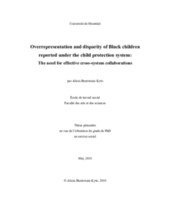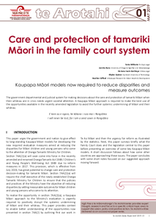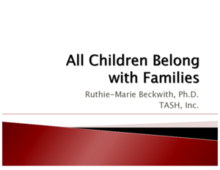Displaying 841 - 850 of 2214
This three-paper dissertation examines the overrepresentation of Black children reported to child protection services in Canada.
This paper urges the government and nation of New Zealand to give effect to long-standing Kaupapa Māori models for developing the new required evaluation measures aimed at reducing the disparities for Māori children and young persons who come to the attention of Oranga Tamariki Ministry for Children.
This presentation was given at Disability Rights International and the European Network on Independent Living's webinar on the right of all children to a family by Dr. Ruthie-Marie Beckwith.
This chapter from the book Re-Visioning Public Health Approaches for Protecting Children considers how the outcomes of alternative care and treatment in child protection can be assessed and the potential promise of public health approaches to child maltreatment.
This chapter from Re-Visioning Public Health Approaches for Protecting Children argues that mentoring for children in foster care in the US should be considered as one potential strategy for the prevention of adverse outcomes among this vulnerable population.
The purpose of this chapter from the book Re-Visioning Public Health Approaches for Protecting Children is to document and discuss the conceptual, methodological, ethical, and infrastructure related issues that arise in supporting the research needs of child welfare organizations in Canada in order to implement evidence-based practice models, while providing examples of the usefulness and challenges of using administrative child welfare data to inform policies and programs.
This chapter from the book Re-Visioning Public Health Approaches for Protecting Children critiques historical and contemporary child protection approaches that are viewed as replicating the colonialist practices of child removal and destruction of families/parenting and communities. Using Australia and Canada as examples, it focuses upon three different sources of the disadvantage and distress that Indigenous communities typically experience: the impacts of Colonisation; intergenerational trauma; and the ongoing social, economic, legal and political inequalities that stem from deep-seated inequity.
This chapter from the book Leaving Care and the Transition to Adulthood explores progress towards realizing the rights of young people in and leaving out of home care in Australia, Sweden and the UK.
This new guide can assist child welfare agencies in planning and implementing best practices in foster parent recruitment, development and support. It features six key drivers for driving better results and offers specific strategies for achieving and sustaining excellence in foster parenting.
This literature review examines research on the outcomes and experiences of Hispanic families in the US child welfare system and how case characteristics interact with the experiences of Hispanic families.




